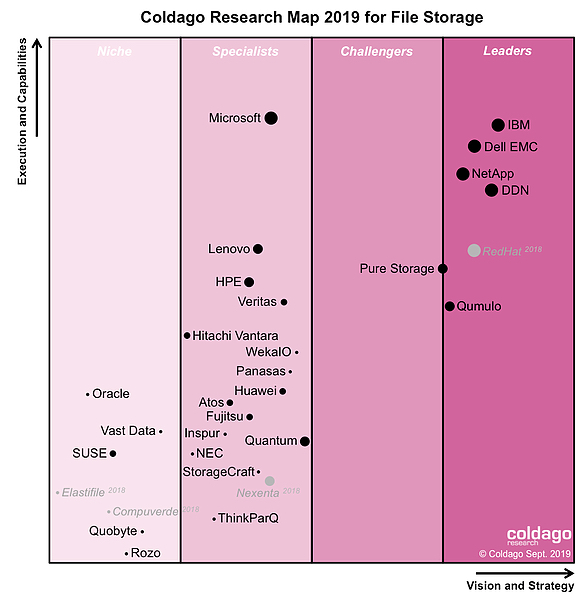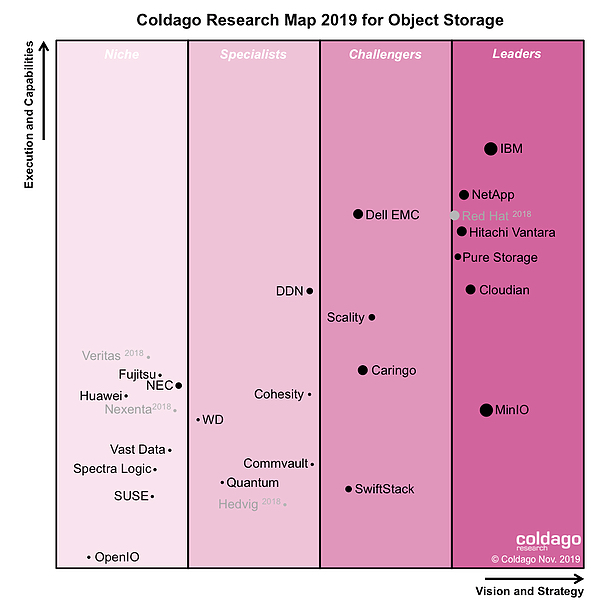Hitachi Vantara Helps Customers Reach New Speeds for Unstructured Data and High-Performance Workloads
Partnership with WekaIO and Hitachi Content Platform capabilities to help gain faster access and insights from unstructured data
This is a Press Release edited by StorageNewsletter.com on July 15, 2020 at 2:20 pmHitachi Vantara LLC, a wholly-owned subsidiary of Hitachi, Ltd., announced a distributed file system and management solution which will help customers gain faster access to and insights from unstructured data such as emails, documents, health records, audio, video and images.
The new solution will be delivered through a partnership with WekaIO, Inc. (Weka), in high-performance, scalable file storage for data-intensive applications.
Hitachi Vantara also announced an expansion of Hitachi Content Platform (HCP), its cloud object storage software solution for connecting data producers, users, applications, and devices. The updates to HCP will better support next-gen unstructured workloads.
The new OEM relationship will enhance Hitachi Vantara’s portfolio with a high-performance, NVMe-native, parallel file system which the company will deliver tightly coupled to a HCP datastore. This performant NAS solution will be suited for use with AI, ML and analytics applications across an array of industries.
The expansion of HCP also better supports next-gen unstructured workloads with performance-optimized all-flash HCP nodes. These new capabilities will deliver 3.4 times more throughout on Amazon S3, resulting in lowered costs of up to 34%.
Updated storage nodes also deliver an improvement of 3x the read and write performance, while simultaneously enabling 3x more capacity in the same rack space as the previous generation. This is significant as traditional NAS, primary workloads and cloud-native workloads are transitioning to object storage to meet high-performance requirements.
The new HCP expansion helps customers translate data into business insights faster, increase revenue from data generated by unstructured data, and improve application performance to drive a better digital experience for end users.
“Organizations that are striving to be data-driven are recognizing the need to tap into vastly increasing amounts of unstructured data to gain a competitive edge,” said Brian Householder, president, digital infrastructure, Hitachi Vantara. “Hitachi Vantara is helping our customers maximize their infrastructure advantage by delivering significant performance improvements when accessing and connecting their data to make faster and more accurate decisions.”
As the size and types of workloads are fundamentally changing, organizations need to focus not only on their ability to scale storage solutions, but also meet performance requirements. For example, at a typical Fortune 500 company, a mere 10% increase in data accessibility can result in more than $65 million in additional net income.
Hitachi Vantara has already demonstrated the benefits of the new HCP capabilities at a financial services customer. The customer needed a higher performance solution for a transaction-heavy core banking application that services more than 50 million consumer and small business clients worldwide. HCP’s all-flash configuration was the solution that could deliver both the performance demanded and the security required as it delivered performance improvements of up to 300%, with some jobs achieving a 1,200% performance improvement over the company’s existing traditional object storage solution.
Another industrial sector customer turned to the company to address growing volumes of manufacturing, sales and distribution data which were stretching the company’s storage infrastructure to breaking point. HCP helped the company achieve a 500% improvement in application response times and enabled the customer to manage massive volumes of unstructured data in varying formats and from multiple sources in a central object store.
“CIOs and IT professionals are no longer looking to object storage only for compliant, archive, tier-two or cold data,” said Amita Potnis, Research Director, infrastructure systems, IDC. “They are now looking at object storage to support new use cases and performant workloads. These organizations are also evaluating distributed file solutions to handle scale and performance to support high-performance computing, real-time analytics and AI.”
Resources:
Blog, Object Storage Comes of Age, by Patricia Harris, Hitachi Vantara VP, digital infrastructure marketing
Infographic, Unlocking Value in Your Unstructured Data
More about Hitachi Content Platform, including the new HCP expansion announced
Comments
Hitachi Vantara does a strategic announcement with this Weka partnership and HCP new product iteration. They clearly accelerate on unstructured data management in various segments. With Lumada Data Services fueled by Waterline Data acquisition, it means that the company is now able to address new challenges in very demanding file environments such as AI.
This deal confirms once again that Hitachi Vantara has a block culture with difficulties to develop, at least to initiate, a file storage product. This is also the case for object. The HNAS product came from BlueArc acquisition (see the table below) and HCP from Archivas absorption.
| Year | Companies |
| 2007 | Archivas |
| 2011 | BlueArc |
| 2012 | Cofio Software Shoden Data Systems |
| 2014 | Sepaton |
| 2015 | Pentaho oXya |
| 2020 | Waterline Data Containership |
The result is interesting as the company can promote now 2 flavors of file storage: continue with scalable NAS with HNAS even VSP N Series, and start with a parallel file system (FS) represented by Weka.
The parallel file system category has grown for a few years powered by new use cases and workloads, new players and the democratization of past technical solutions. Hitachi Vantara has selected a modern approach of parallel file system that really shakes the category and started to penetrate enterprise with a commercial model.
Among the relevant parallel FS products that count on the market, can be listed IBM Spectrum Scale (aka GPFS), Panasas, Weka, BeeGFS and Lustre-based products like DDN Exa5 and previously ExaScaler.
The table below illustrates some partnerships and parallel file system related products and technologies used by a selection of vendors.
| Companies | Partnerships and technologies |
| Cisco | Weka |
| DDN | Lustre, IBM Spectrum Scale (deal stopped), pNFS |
| Dell EMC | BeeGFS, Lustre, IBM Spectrum Scale, Weka, pNFS |
| Fujitsu | Lustre, pNFS |
| HPE | BeeGFS, Lustre (for Cray), IBM Spectrum Scale, Panasas, Weka, pNFS |
| Hitachi Vantara | Weka, pNFS |
| Huawei | Lustre, pNFS |
| Lenovo | Lustre, IBM Spectrum Scale, Weka, pNFS |
| NEC | BeeGFS, Lustre, IBM Spectrum Scale, Quobyte |
| NetApp | BeeGFS, pNFS |
| Penguin Computing | Weka |
Weka is listed as a specialist in the Coldago Research Map 2019 for File Storage Hitachi Vantara is well positioned as well being in the leader part of the other Map published by Coldago named Map 2019 for Object Storage. Hitachi Vantara produces a serious HCP evolution with flash nodes, high capacity (15PB per rack and 1EB per cluster) and real performance boost in write and read mode.


Hitachi Vantara made a mistake in paragraph 4 claiming that Weka is a NAS and it's not. Even Weka doesn't promote itself with this positioning as the team competes every day against NAS. Weka is a parallel FS as it is written in the PR in other places and not a NAS at all. Exposing files, these 2 approaches are chosen for different workloads even if we see some convergence, some high performance NAS entered the IO500 list like VAST Data and Qumulo and at the same time parallel FS penetrates enterprises. with a new commercial image pushed by players like Weka or Panasas. Users who choose parallel FS expand a few times with NAS protocols at the client level. but we never meet a case where a parallel FS was picked to do only NAS. For that, users select a pure NAS product.
To make a NAS parallel, the NFS protocol offers pNFS (parallel NFS) listed by many vendors with their official NFS 4.1/4.2 support but finally very limited in term of deployment. An other option exists, nConnect, for client multiplexing but it's not parallel as the operation is not split and not sent to multiple back-end data servers.
To summarize parallel FS and high end NAS offering on the market here is a new table below:
| Parallel FS | High end NAS |
| DDN Exa5 | Dell EMC PowerScale |
| IBM Spectrum Scale | Hitachi Vantara HNAS |
| Lustre-based products | NetApp FAS |
| Panasas | Pure Storage FlashBlade |
| Quobyte | Qumulo |
| Weka | VAST Data |
This Hitachi Vantara announcement will shake a bit the market as now the company has a serious offering coupling a super fast parallel FS with a proven high end object storage.














 Subscribe to our free daily newsletter
Subscribe to our free daily newsletter

